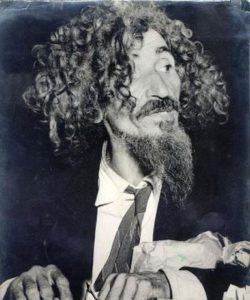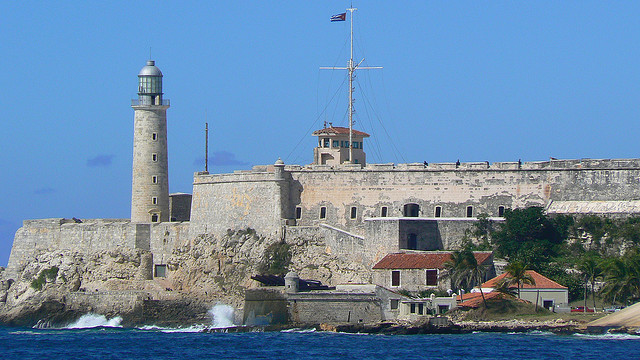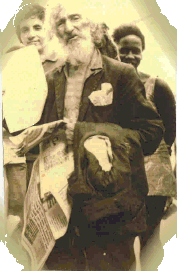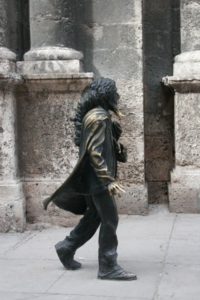“The Knight of Paris” (El Caballero de Paris) or José María Lledín, his real name, was born on December 30, 1899 in Spain and as clarification he was not a vulgar vagabond. He was simply a man who, as he lived in a mentally free society, gave himself to respect and turned away from it, to have a world of his own and to find for his life the best of adventures: to travel without fear in the streets of Havana.
He was a polite and polite man, never begging anyone and only accepting them from those people he knew returning their attention with a gift, which could be a card colored by him or a handle of pen or pencil understood with threads of different colors, a pencil sharpener, or similar object.
Dr. Calzadilla was the last psychiatrist who attended El Caballero en Mazorra. The book published by the about ‘The Knight of Paris’ contains a large amount of data, obtained from interviews with El Caballero, his family and people who knew him.
According to his sister Innocencia, Jose fell in love with Merceditas, the daughter of a doctor from Fonsagrada. She died as a young man and Joseph was at her side when she died. The day he died, Joseph swore he would never marry and always kept his promise.
Most reports agree that José lost his reason and became “El Caballero” when he was arrested in 1920 and sent to the Castillo del Principe prison in Havana for a crime he had not committed.
When he began to ambulate the streets of Havana, his family gathered to see what could be done to help him. The family decided that it would be best if he returned to his hometown to live with his parents. When this decision was communicated to “El Caballero”, this one was greatly altered and said that if they embarked for Spain, he would kill himself by throwing himself into the sea. The family gave up on these efforts, but the result was that “El Caballero” and his family were more distant.
Both Javier and Mercedes, the sister of “El Caballero”, say that “El Caballero” took his name from his girlfriend from Paris, who died while traveling to meet him in Havana.
On December 7, 1977, “El Caballero” was interned at Mazorra as a humanitarian act. The main reason for his internment was not that he threatened anyone but his deplorable physical condition Alli was bathed and his hair was cleaned and arranged in the form of a long braid. The diagnosis of his psychiatrist is that he suffered from paraphrenia, sometimes considered as a form of schizophrenia. He was not suffering from hallucinations.
He died at 1:45 AM on July 11, 1985 at the age of 86. Initially, he was buried in the cemetery of Santiago de las Vegas in Havana, his remains were exhumed by Eusebio Leal and transferred to the convent of San Francisco de Asis, his present resting place.
Today, its statue that for tourist purposes and reminder the Cuban government has placed in the old Habana has managed to turn it into a perpetual symbol of freedom. His solitary figure in bronze makes us know that no one, no matter how much power he may have, can already prohibit his pilgrimage, free and eternal through the streets of our beloved capital.
RECUERDOS DE UN DIGNO PEREGRINO EN LIBERTAD, EL “CABALLERO DE PARÍS”.
El Caballero de París o José María Lledín, su verdadero nombre, nació el 30 Diciembre de 1899 en España y como aclaracion no era un vulgar vagabundo. Era simplemente un hombre que, como vivía en una sociedad mentalmente libre, se dio a respetar y se apartó de ella, para tener un mundo propio y encontrar para su vida la mejor de las aventuras: peregrinar sin miedo por las calles de la ciudad.
Era un hombre educado y cortés, nunca pedía limosnas a nadie y sólo las aceptaba de aquellas personas a las cuales conocía devolviéndoles su atención con un obsequio, que podía ser una tarjeta coloreada por el o un cabo de pluma o lápiz entizado con hilos de diferentes colores, un sacapuntas, u objeto similar.
El Dr. Calzadilla fue el último Psiquiatra que atendió a El Caballero en Mazorra. El libro publicado por el sobre ‘El caballero de Paris’ contiene gran cantidad de datos, obtenido de entrevistas con El Caballero, su familia y personas que lo conocían.
Según su hermana Inocencia, José se enamoró de Merceditas, la hija de un médico de Fonsagrada. Ella murió de joven y José se encontraba a su lado cuendo ella murió. El dia que murió, José juró que nunca se casaría y siempre mantuvo su promesa.
La mayoría de los reportes estan de acuerdo que José perdió su razon y se convirtió en “El Caballero” cuando fue arrestado en 1920 y remitido a la prisión del “Castillo del Principe” en La Habana, por un crimen que no habia cometido.
Cuando comenzó a ambular por las calles de la Habana, su familia se reunió para ver lo que se podia hacer para ayudarlo. La familia decidió que lo mejor sería que el regresara a su pueblo natal para vivir con sus padres. Cuando le comunicaron esta decision a “El Caballero”, este se alteró de sobremanera y dijo que si lo embarcaban para España, el se mataría tirandose al mar. La familia desistio en estos esfuerzos, pero el resultado fue que “El Caballero” y su familia quedaron mas distantes.
Tanto Javier como Mercedes, la hermana de “El Caballero”, dicen que “El Caballero” saco su nombre de su novia de Paris, que pereció cuando viajaba a reunirse con el en La Habana.
El 7 de Diciembre de 1977, “El Caballero” fue internado en Mazorra como acto humanitario. La razón fundamental para su internamiento no fue que amenazaba a nadie, sino su estado físico deplorable Alli fue bañado y su pelo fue limpiado y arreglado en forma de una larga trenza. El diagnóstico de su psiquiatra, es que padecía de parafrenia, algunas veces considerado como una forma de esquizofrenia. El no sufría de alucinaciones.
Murió a la 1:45 AM el 11 de Julio de 1985 a la edad de 86 años. Inicialmente, fue enterrado en el cementerio de Santiago de las Vegas en La Habana, sus restos fueron exhumados por Eusebio Leal y transferidos al convento de San Francisco de Asis, su presente lugar de descanso.
Hoy, su estatua que con fines turisticos y recordatorio el gobierno cubano ha colocado en la vieja Habana ha logrado convertirlo en un símbolo perpetuo de la libertad. Su figura solitaria en bronce nos hace saber, que nadie, por mucho poder que tenga, puede ya prohibirle su peregrinar, libre y eterno por las calles de nuestra querida capital.
Agencies/Luna/Internet Photos/Arnoldo Varona/TheCubanHistory.com
THE CUBAN HISTORY, HOLLYWOOD.










